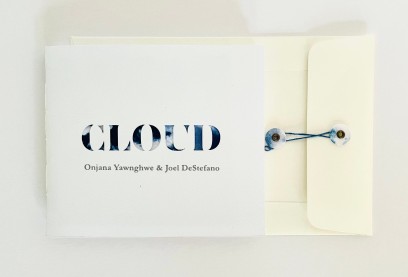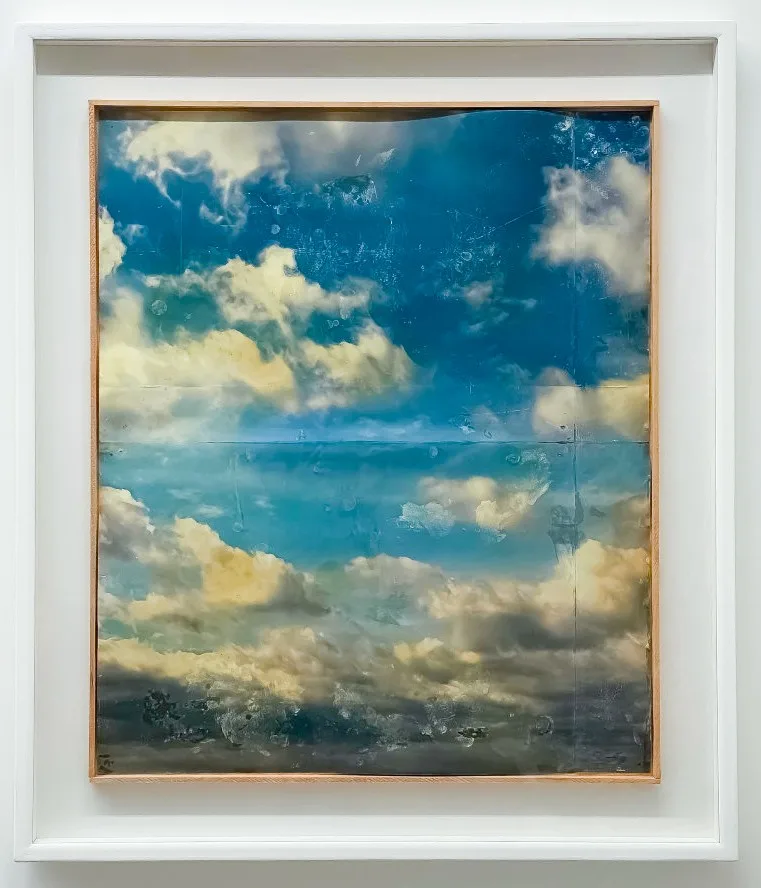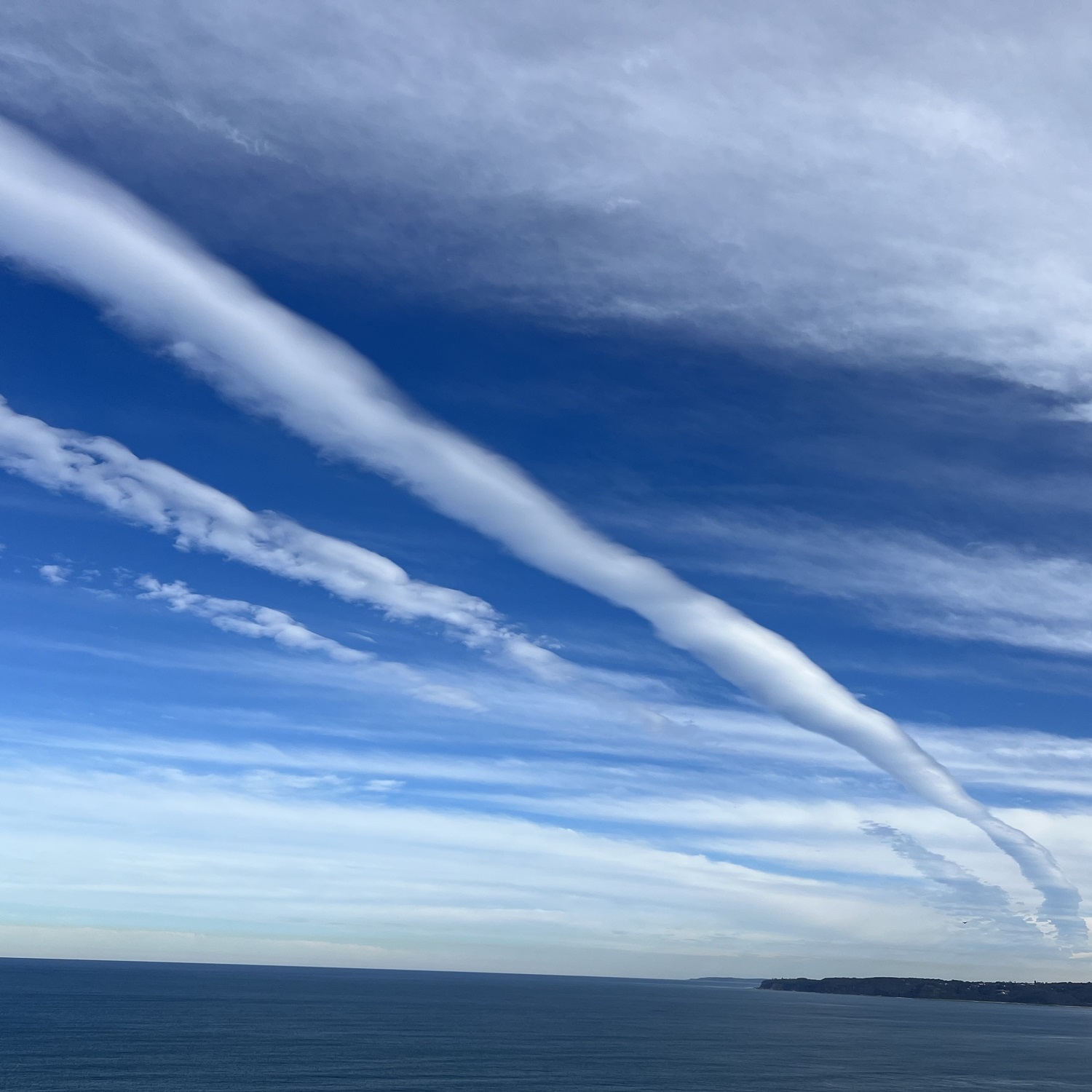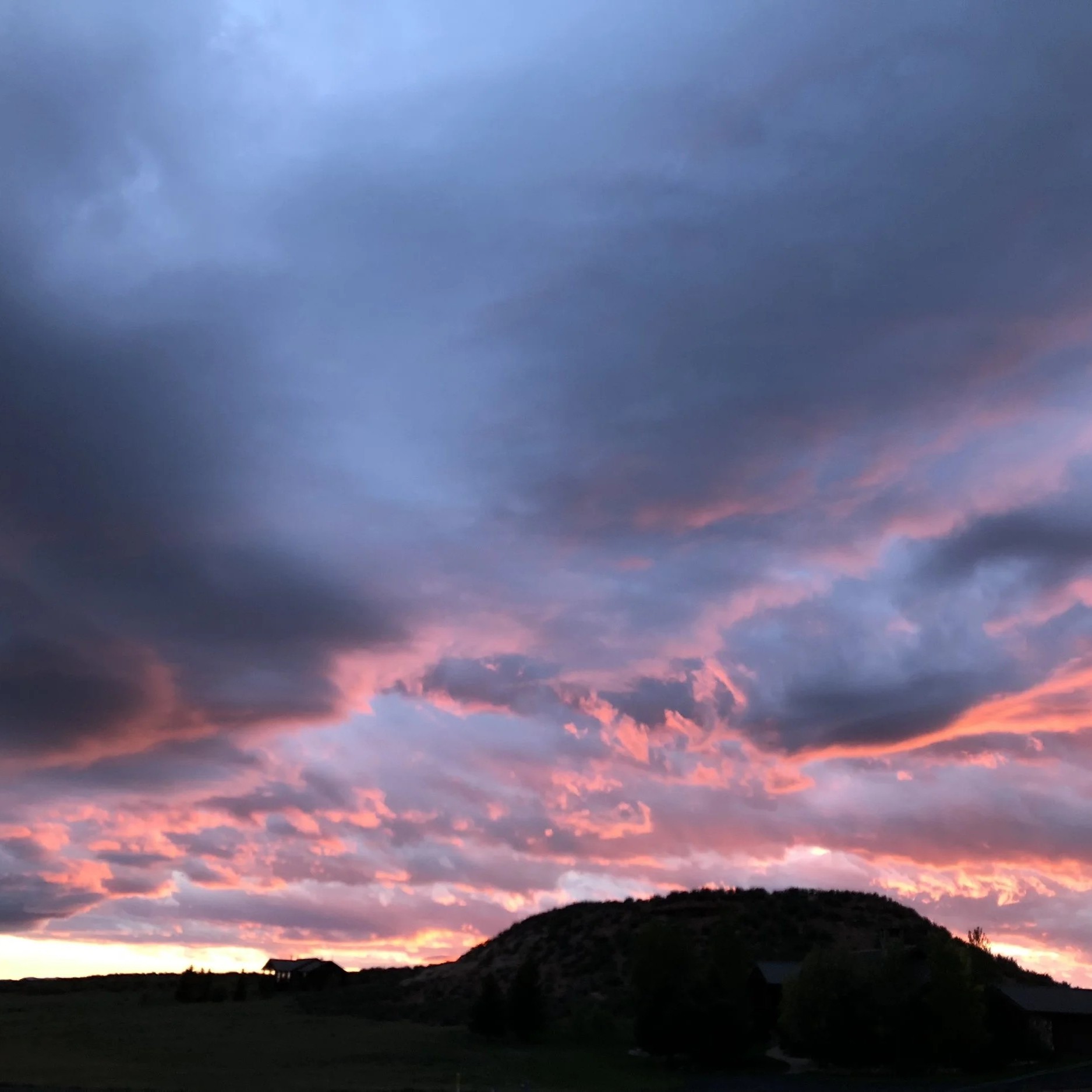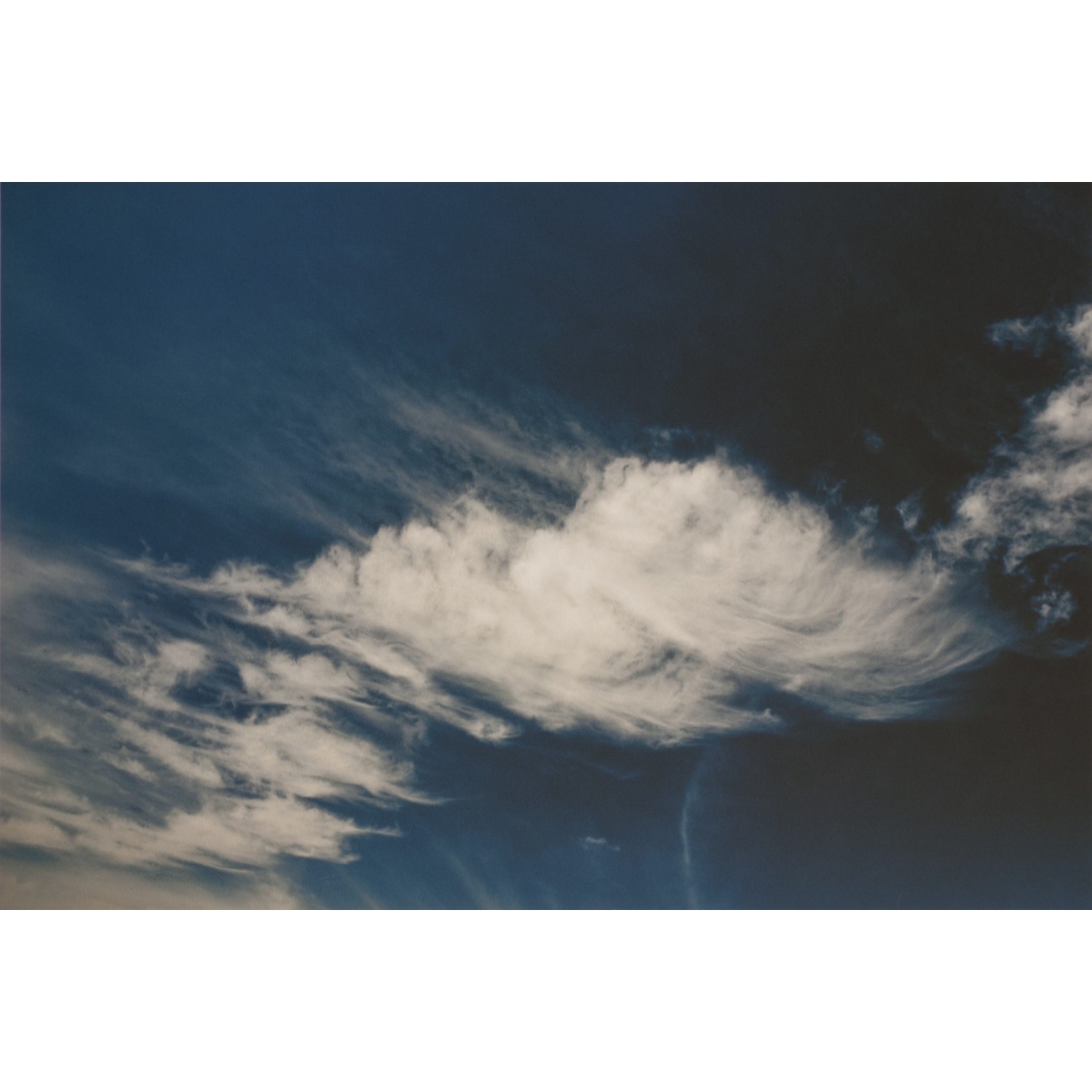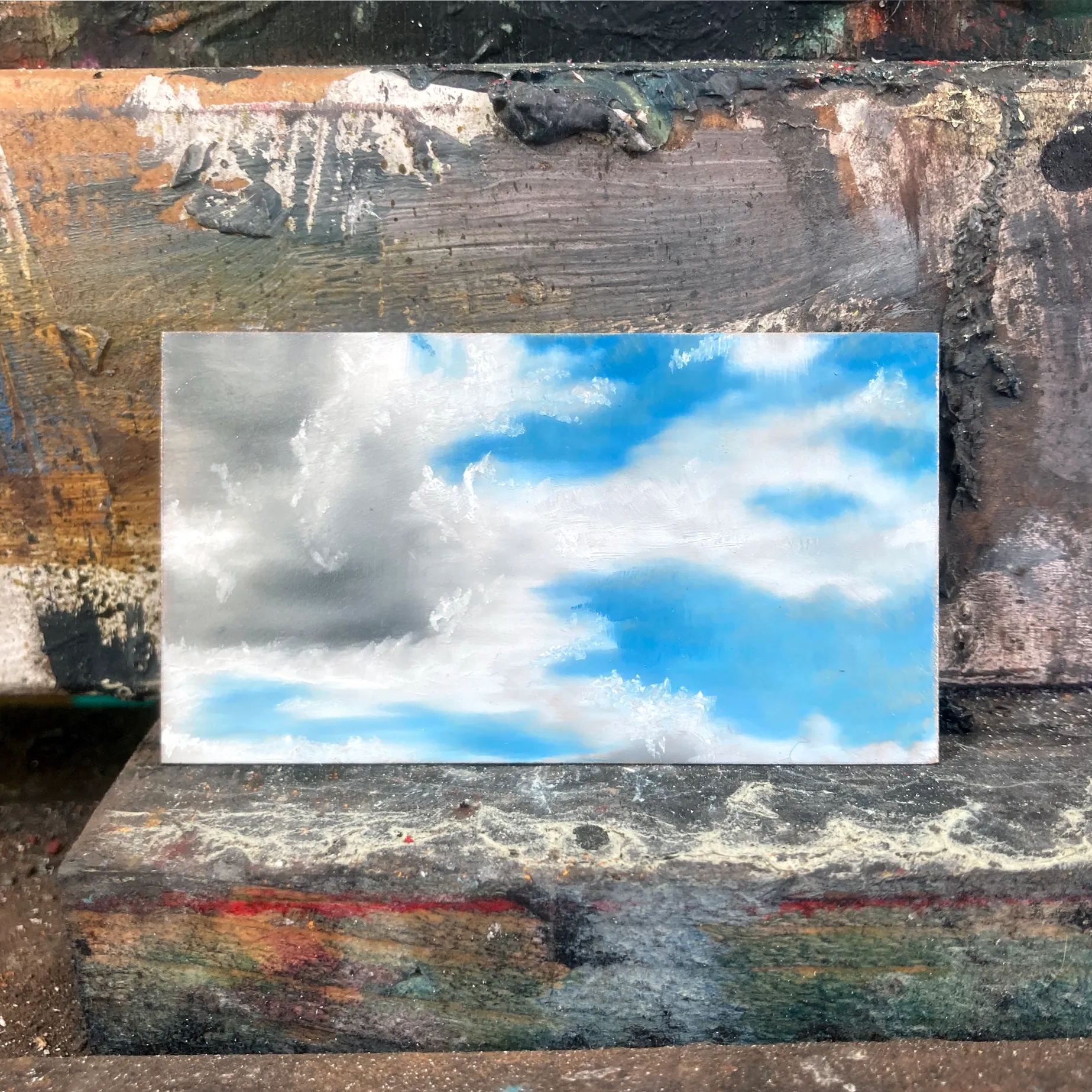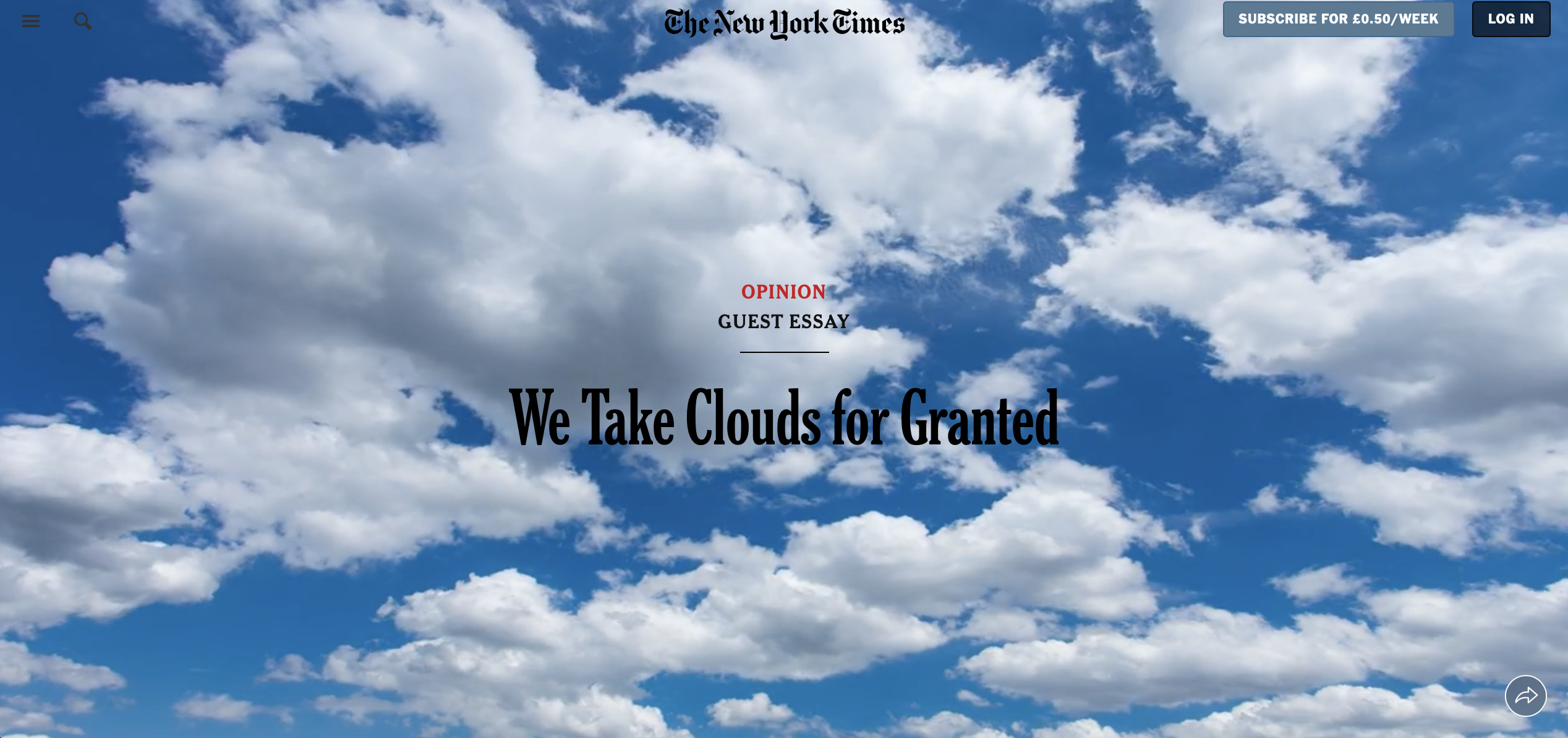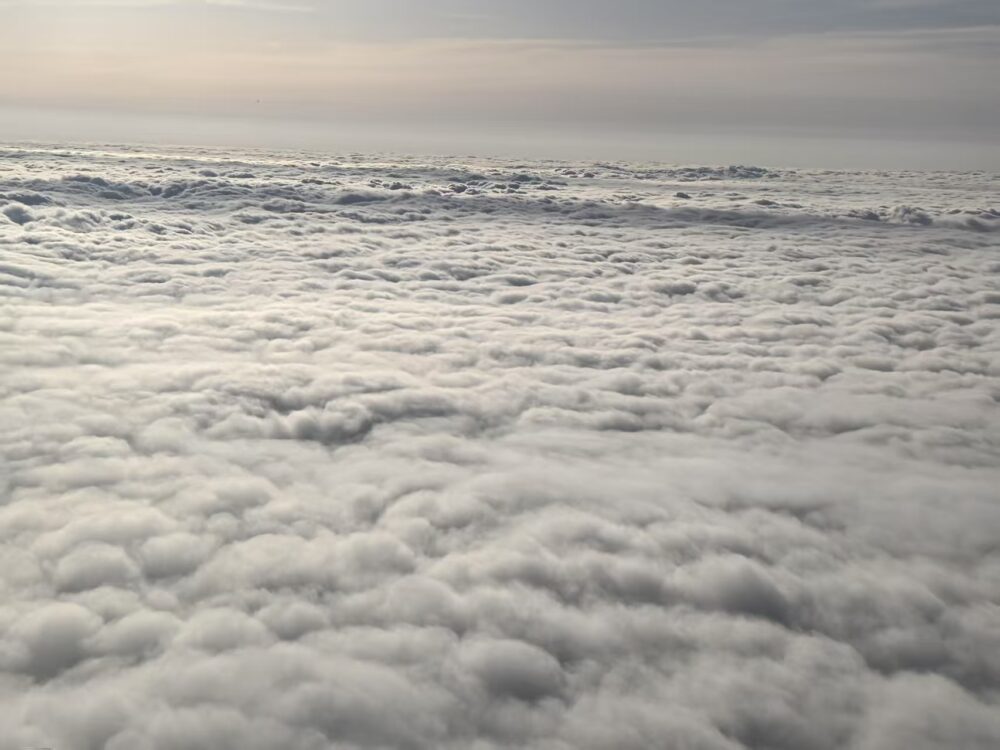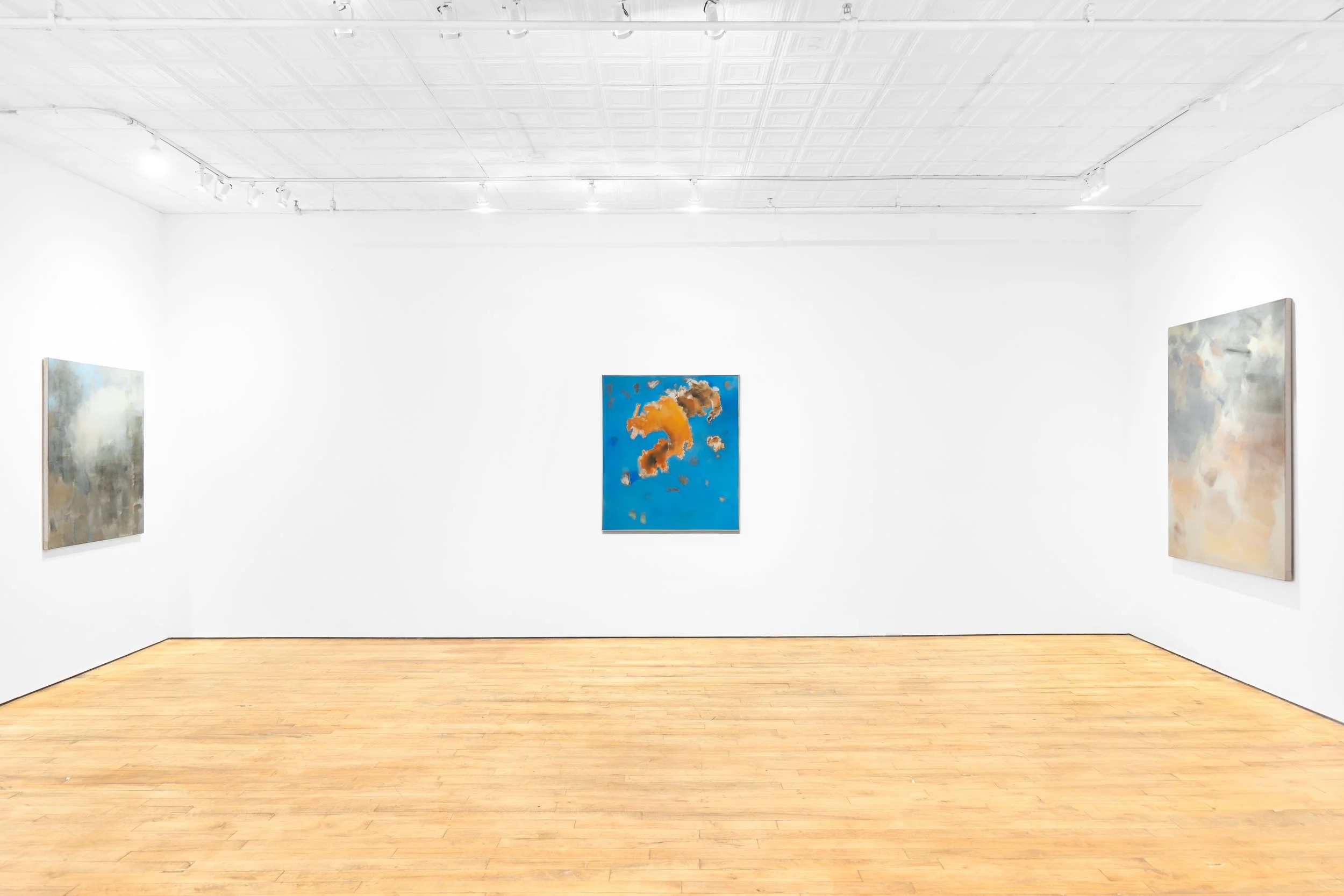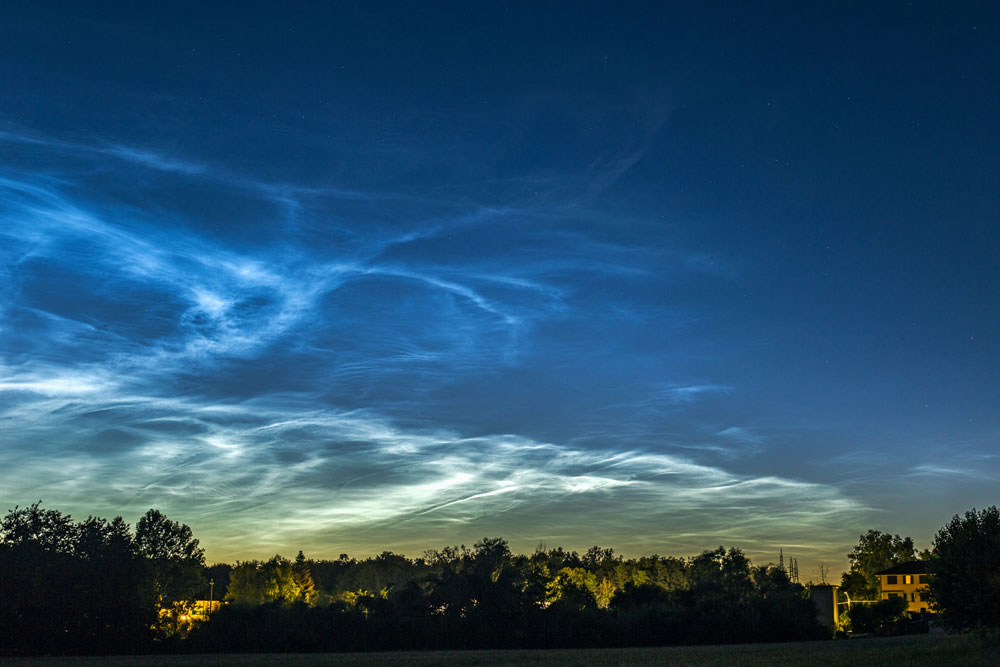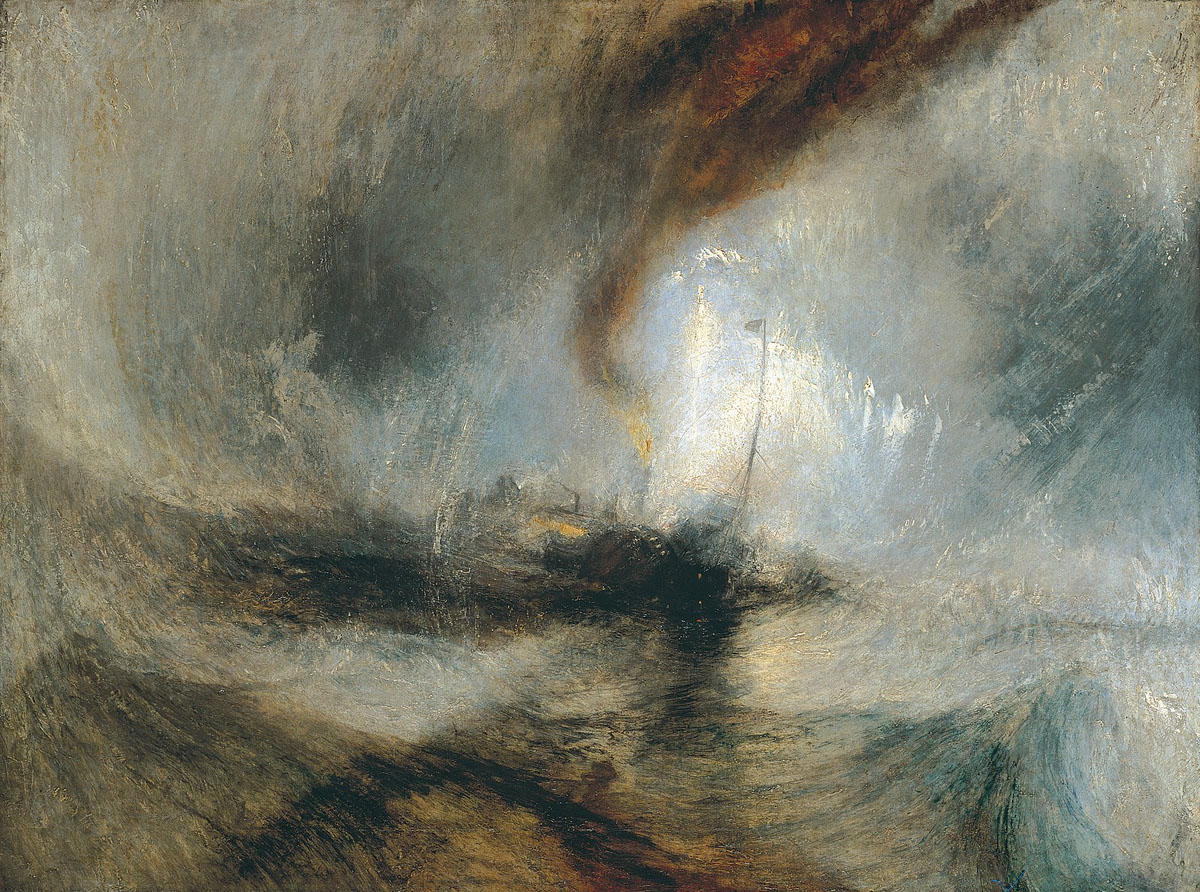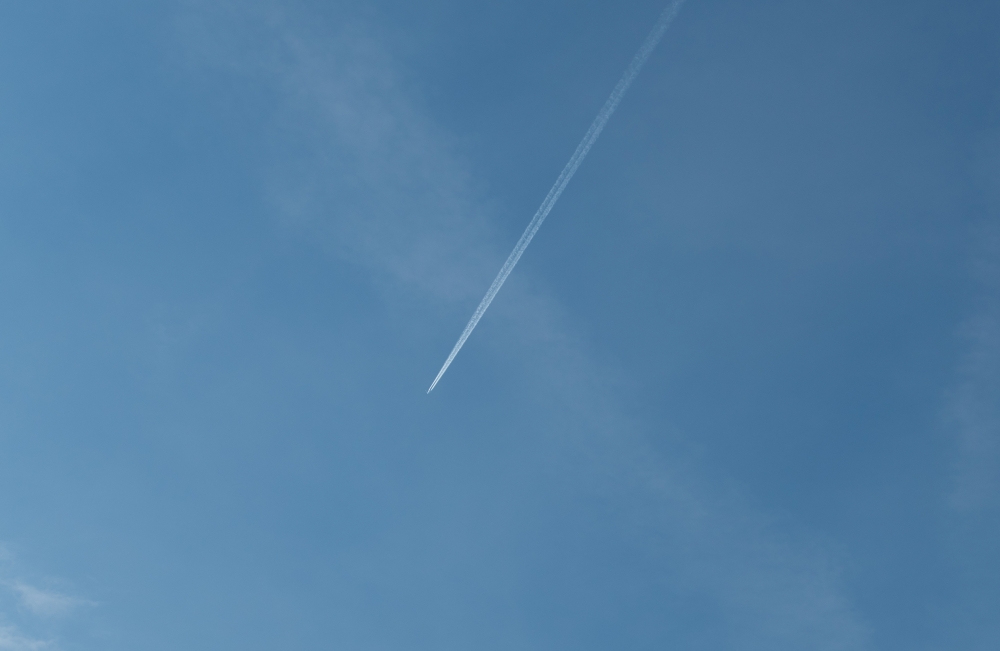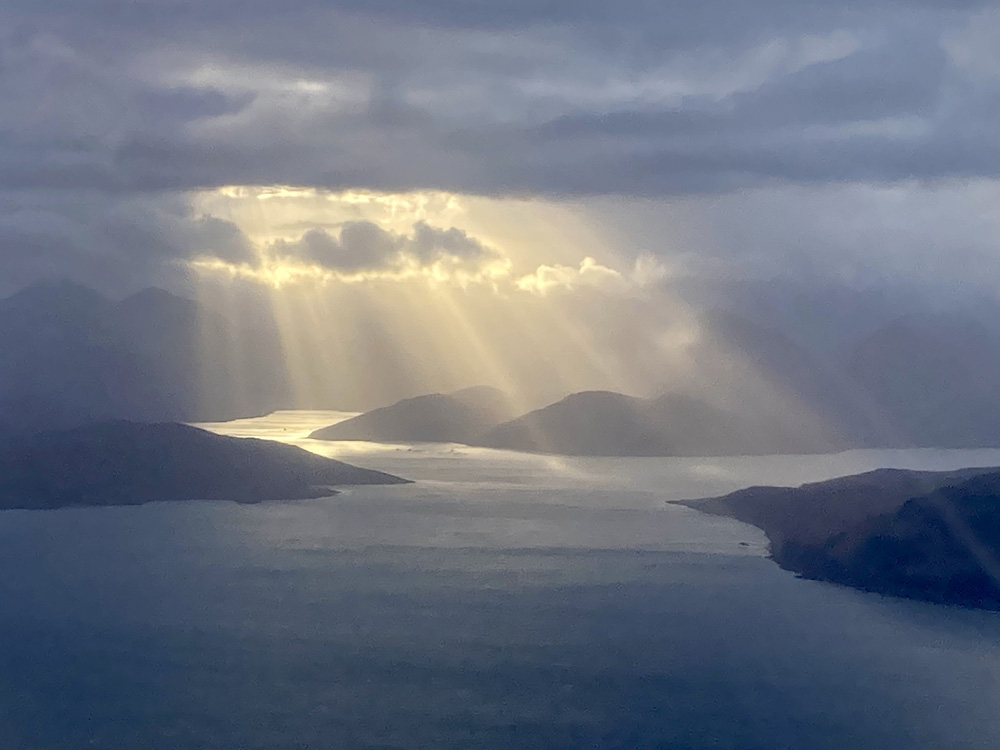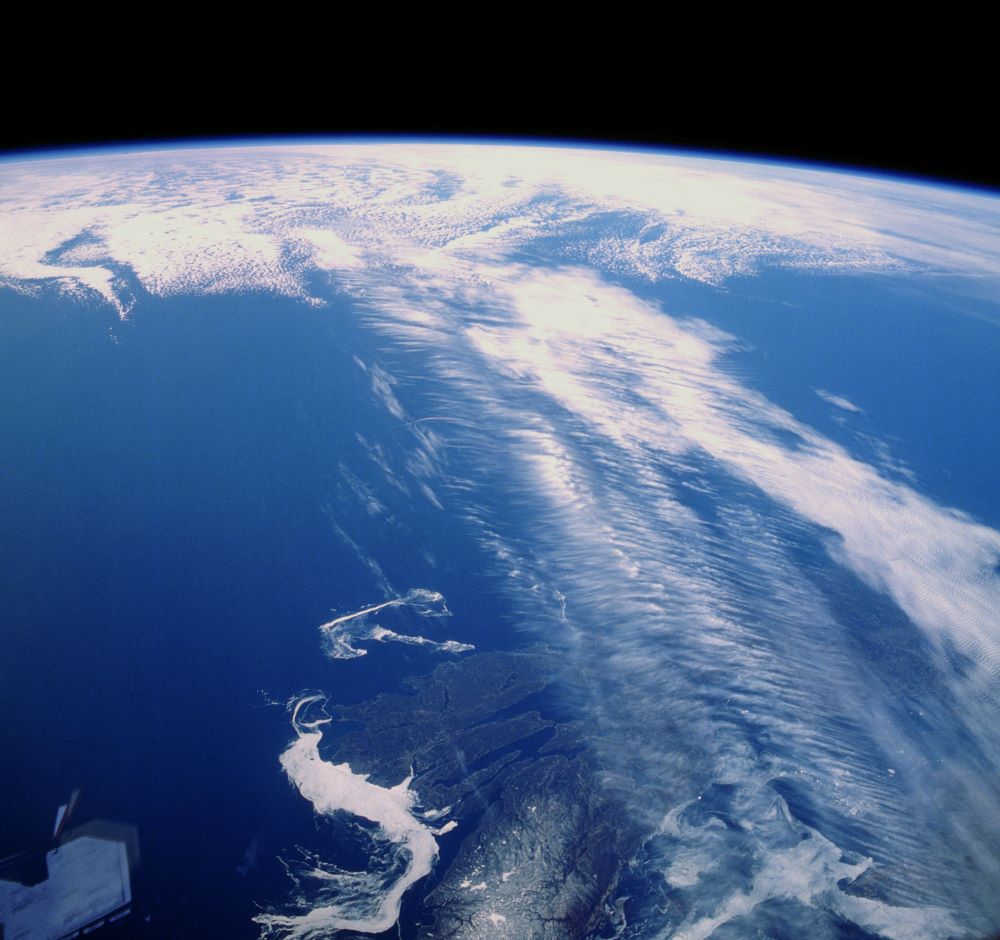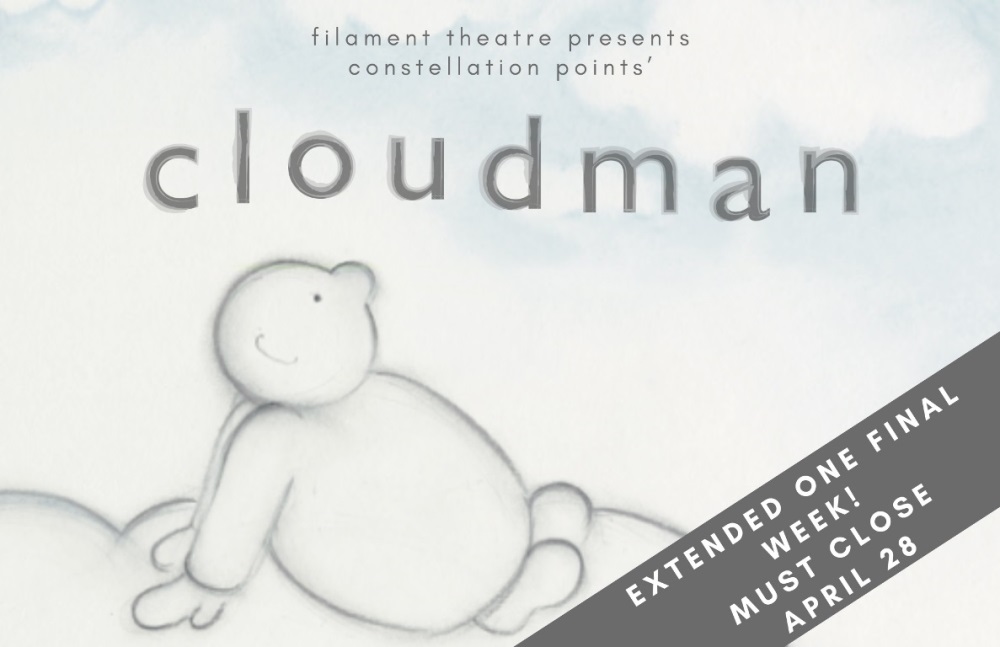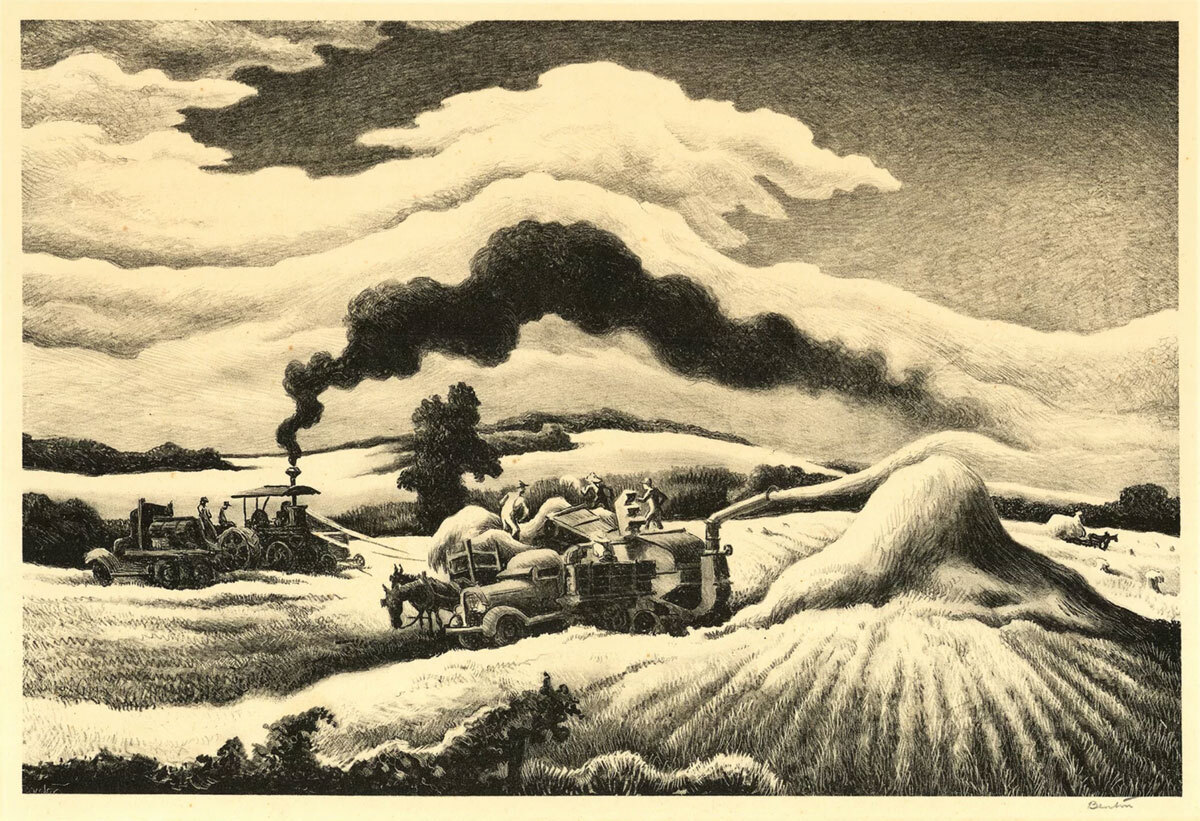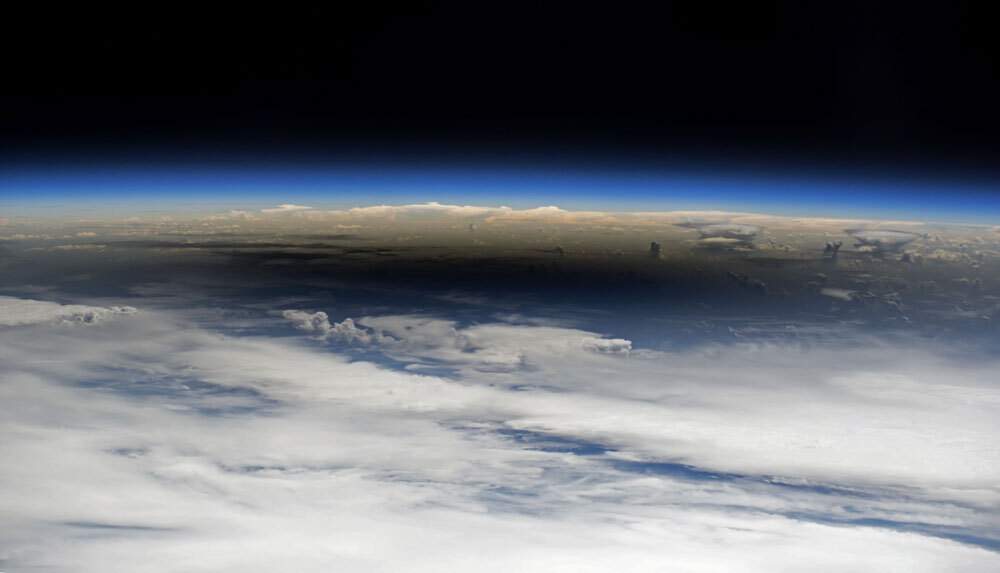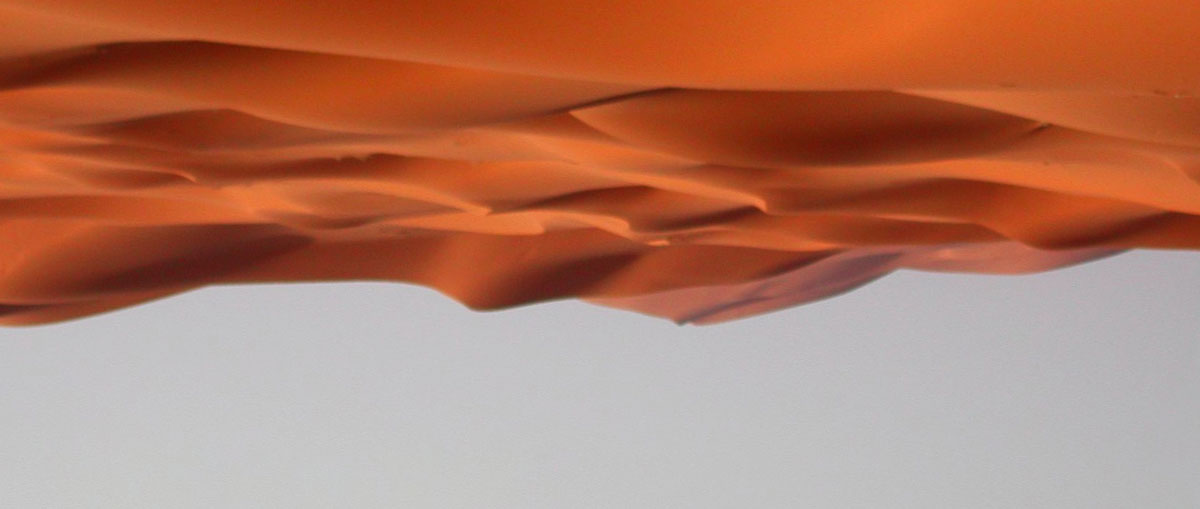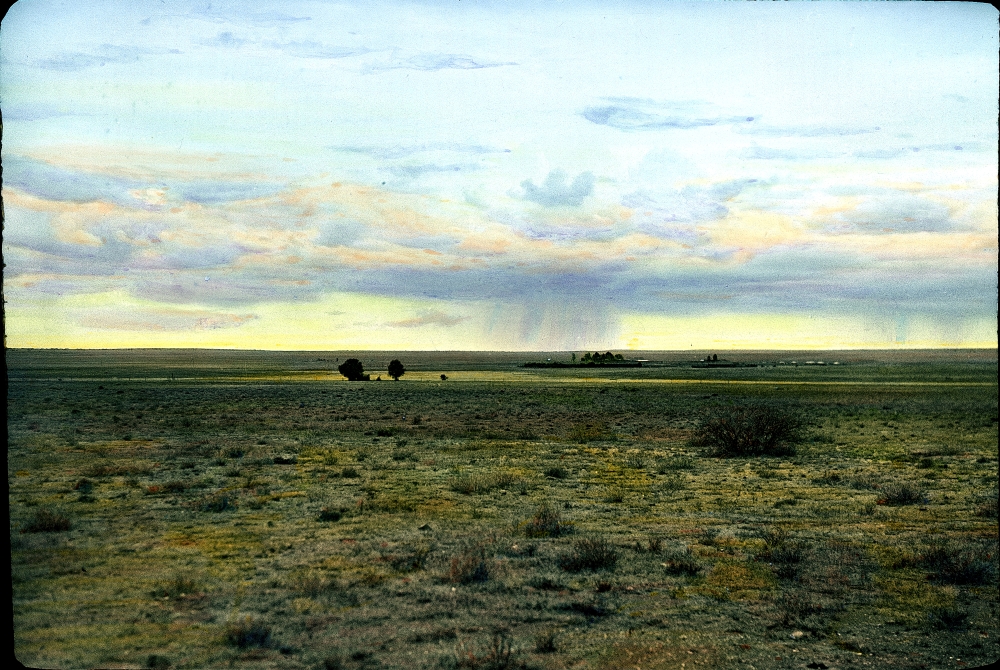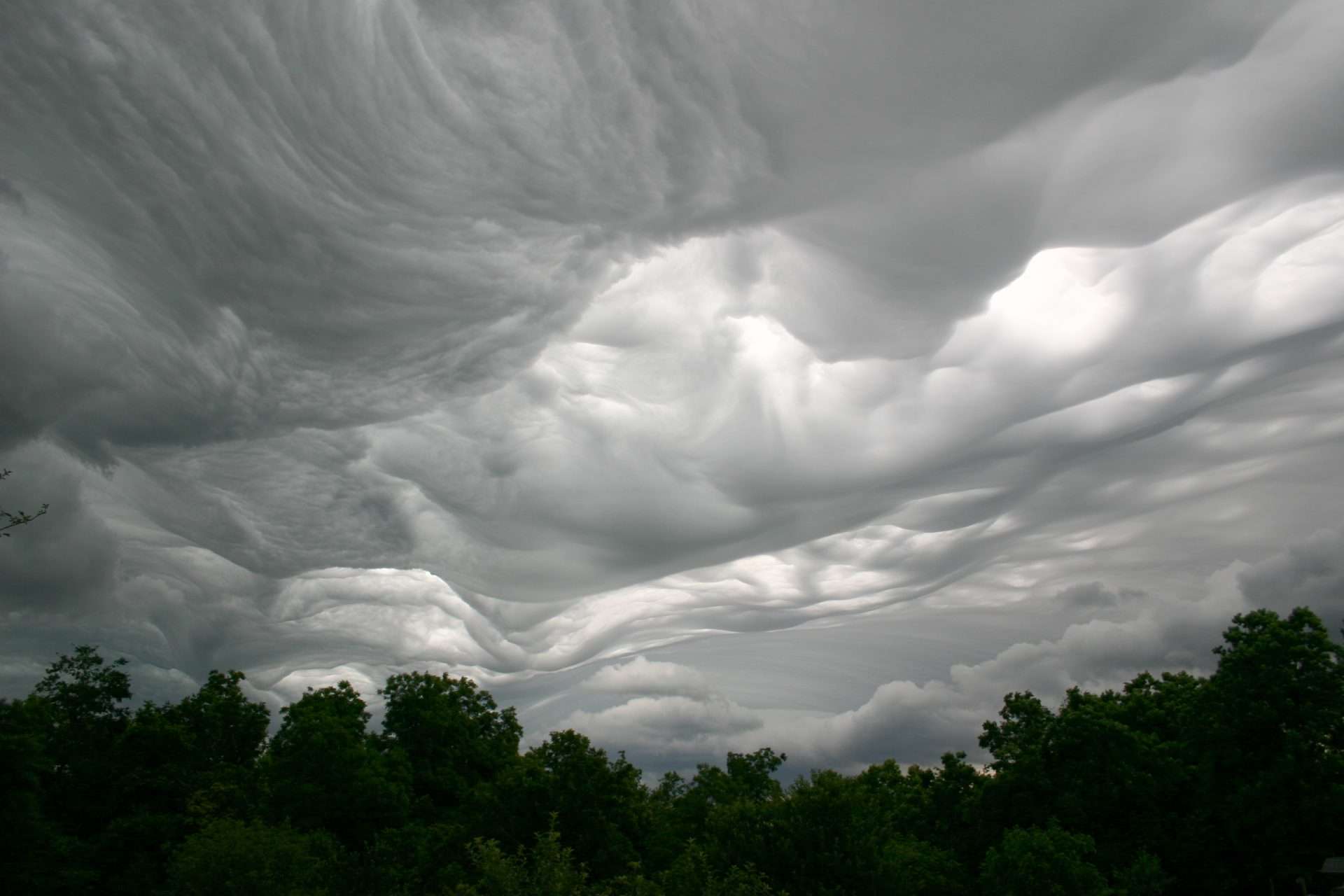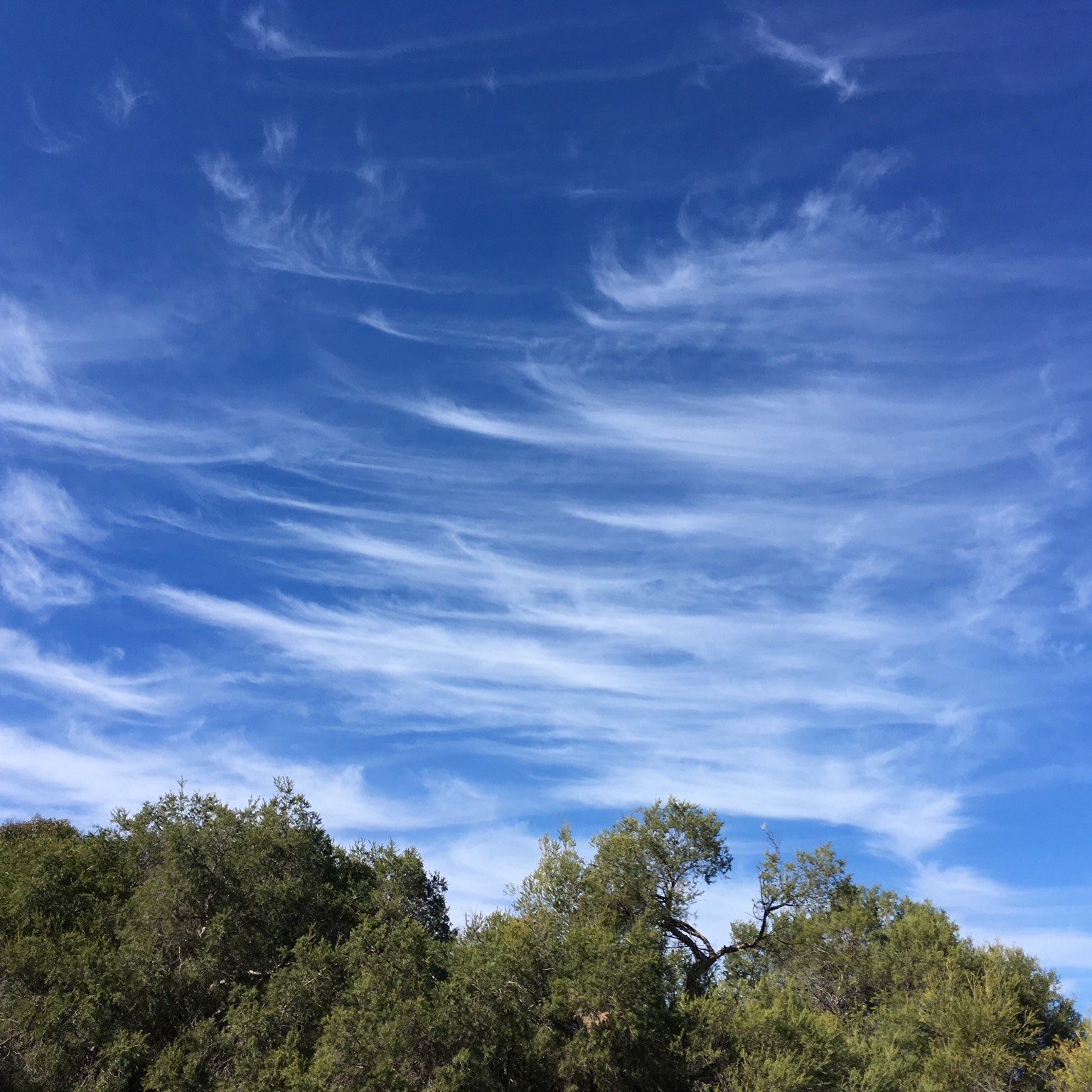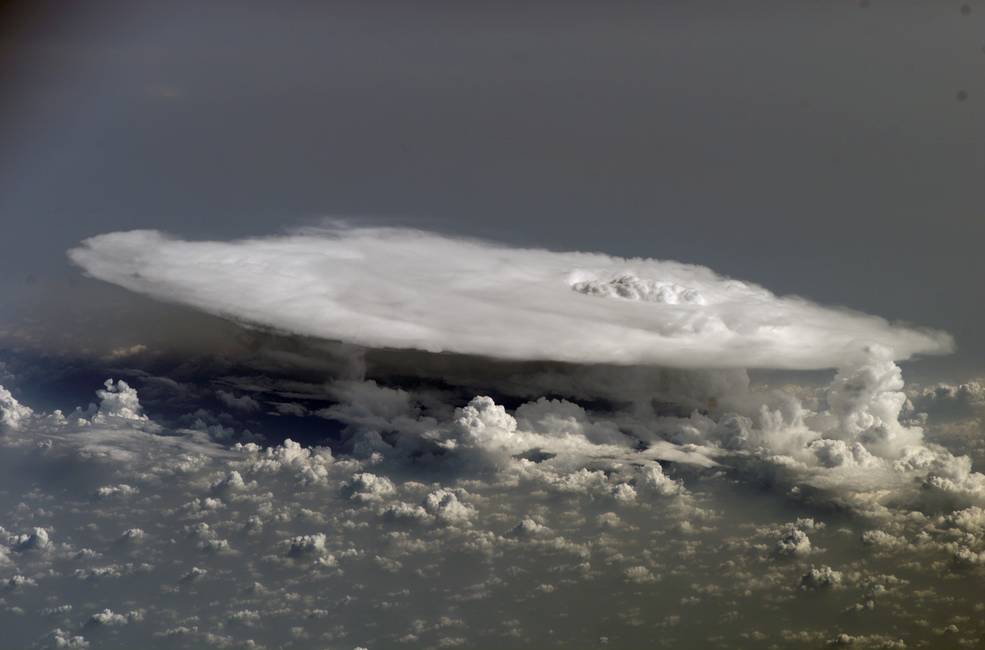“CLOUD” is a handmade artist book produced in a limited edition of 64 copies created by interdisciplinary artist Joel DeStefano and poet Onjana Yawnghwe. They told us “CLOUD is both playful and enigmatic, inviting readers to pull open, fold, and unfold pages while contemplating the skies above. It is an interactive book for divining the meaning of clouds; a contemporary play on a grimoire for uncertain times”.
Category: Attention All Cloudspotters
You can’t look around when you’re looking up, so we’ve had a look around for you.
If you have cloud news that you think we should include here, please email it to us at: hello@cloudappreciationsociety.org.
A Tragedy of Infinite Beauty is a solo exhibition by Doug & Mike Starn at HackelBury Fine Art, London W8. On the exhibition website Doug & Mike explain “The cloud is the inevitable thought, the thing with no permanent shape, drifting through the clarity of blue and silent mind. As the cloud changes continually, the watcher only watches it until losing interest, and as awareness of it slips by, the thought’s gone out of sight. They always will be — old, worn, and always new.”
The exhibition runs from 8th October 2025 to 28th February 2026 and in it the artists present new works which reflect on impermanence, perception, and the tension between beauty and destruction. The two series on view, Under the Sky and Everything Is Liquid, explore the overwhelming yet often unnoticed forces – atmospheric, emotional, geological, and cultural – which shape our lives.
Find out more about the exhibition
Image: It’s a beautiful Day 2025 © Doug & Mike Starn
Robin Boord, Member 6,556, wrote the essay “Consolation of Clouds” that won third prize in the Calibre Essay Prize and was first published in the Australia Book Review. Robin recounts the mystery that surrounded her father’s death. He was a pilot in the Korean War and died at home following a training flight that had encountered mechanical failures.
Read the full essay here
Robin’s novel “Out of Place” will be published by Picador in 2026.
Image credit – A long range view of an Altocumulus volutus, otherwise known as a Roll cloud, extending northward 50 kilometers. In total, it was reported that this band extended 300 kilometers. This photograph was taken near Newcastle, New South Wales, Australia. © Doug Goold
Ellen Webster, Member 65,774 recently wrote the article “Why I’m Cloud Gazer #65,774” for her blog. She draws on her childhood memories of spotting shapes in the clouds and, sixty years later, she still lives in that beauty and is still struck by how clouds link us. In her article she explains “same sky, same atmosphere, same water cycling endlessly between us. As a child who’d never left the cocoon of rural Maine, I felt oddly connected to children in Mumbai and Tokyo, also watching clouds pass overhead. That sense of unity is still there when I look up”
Read Ellen’s delightful article on her blog
Helen Glazer, Member 20,787, is an artist with six photographs included in the exhibition “Clouds: A Collaboration with Fluid Dynamics”. The exhibition is showing until December 14, 2025 at the Benton Art Museum of the University of Connecticut, Storrs, CT, USA and also includes cloud photographs by several other artists. The inspiration for the exhibition was the work of UConn professor George Matheou, whose lab studies fluid dynamics and among other things, has created a computer model of cloud formation over the ocean that is also in the exhibition.
Read this article for more about George Matheou’s work
Exhibition information can be found here
See more of Helen’s work on her website
Robert Jackson, an Irish artist currently living in Scotland, creates miniature paintings using oil on roughened brass plates. He studied Fine Art Printmaking at the NCAD and received his MFA from DJCAD, Dundee. During his studies, his primary art practice involved painting, printmaking and drawing. He is a prolific artist and paints daily in his studio in Fife, Scotland.
His upcoming solo exhibition “The Clouds Seem Different Here”, is showing at Cahir Arts Tipperary, Ireland from 14th October to 15th November 2025.
Find out more about the exhibition
View more of Robert’s Tiny Skies work on his website
Thank you to Edward Denniston for telling us about Robert Jackson and his work.
Asterisk Labs and the Cloud Appreciation Society are delighted to invite you to an online ‘fireside chat’ between Gavin Pretor-Pinney (Member 001) and Dr Ed Gryspeerdt.
The event will take place on Friday, 19th September from 16.00 to 17.00 BST and you can register to join the event here.
Gavin is Founder of the Cloud Appreciation Society. Ed is a Royal Society University Research Fellow at Imperial, and an expert on the physics and properties of clouds and their role in the Earth’s climate system.
Register to join Clouds & Climate on Friday 19th September 16:00 BST
In a Guest Essay for The New York Times, Cloud Appreciation Society founder Gavin Pretor-Pinney (Member 001) shares why clouds matter more than ever, not only for their beauty but for their critical role in regulating Earth’s climate.
From cooling parasols to warming blankets, clouds are central to the story of our changing atmosphere. And as climate science catches up, so must our appreciation.
Read the full article in today’s New York Times: “We Take Clouds for Granted” by Gavin Pretor-Pinney.
“What Thanks Would You Give to the Clouds?” is an exhibition by Takaaki Okada and Christian Orellana who are based in Portland, Oregan. The project, inspired by clouds, is currently at the A Gallery in Seattle, WA running until 31st October 2025.
Find out more about the exhibition
High above us, in the chilly, windswept world of clouds, scientists have discovered a thriving community of airborne microbes—bacteria and fungi that not only survive but may play a vital role in shaping our weather. These resilient organisms hitch rides on water droplets and ice crystals, influencing cloud formation and even precipitation. Researchers are now exploring how these microscopic lifeforms could affect climate patterns and atmospheric chemistry. This field of research suggests that the clouds are alive in ways we are still only beginning to understand.
You can see the full article on the BBC.com website and we’d like to thank Marion Warwick, Member 43,449 for letting us know about it.
Image Credit: Above the clouds over Pudong New Area, Shanghai, China © Xīn yí Sūn
Leah Margosis, Member 44,374, recently contacted about an exhibition at the Storage Art Gallery in New York featuring artist, Jacqueline Gourevitch. The exhibition is called “A Head in the Clouds” and, while it is closing on August 1 2025, you can still view it online.
Jacqueline Gourevitch was born in 1933 and the exhibition includes her series of “Cloud Paintings” which she began in the 1960s. A keen understanding of the light and color of the sky distinguishes her work from what might initially appear to be color field compositions rendered in neutral tones. Whites, greys, and blues delicately meld in ways that both carefully reflect and reinterpret the moment before a storm breaks.
Born in Paris, Jacqueline Gourevitch moved to the United States in 1940. She studied at the Black Mountain College. In 1973 she was included in the Whitney Biennial and in 1975 she showed at the Wadworth Atheneum in Hartford, Connecticut as part of their Matrix series.
Noctilucent cloud season is upon us in the Northern Hemisphere, and NASA has a citizen science project for noctilucent cloudspotters to get stuck into.
Forming in summer months at altitudes of around 50 miles (80.5 km), noctilucent clouds are Earth’s highest clouds. They are only visible during twilight hours, when the rest of the sky is dark but the Sun’s rays are still able to reach way up into the mesosphere from behind the curvature of the Earth. They illuminate these otherwise invisible clouds with an electric blue colour. Their noctilucent name means ‘night shining’ in Latin. While noctilucent clouds are typically seen in latitudes closer to the Poles, they have in recent years been spotted more and more frequently from lower latitudes.
In their Space Cloud Watch project, NASA are inviting members of the public to share their observations and photographs of noctilucent clouds. They are also interested in reports of nights when they have not been observed. The aim is to create a global map of noctilucent cloud sightings, with the purpose of gaining a greater understanding of why these extreme-altitude ice-crystal clouds have been seen over increasing regions of the world in locations farther from the Poles.
Find out more on the Project summary page.
Check out the supporting field guide for observing noctilucent clouds.
Contribute your observations on the Space Cloud Watch website.
Image: Noctilucent clouds over Sumirago, Varese, Italy by Paolo Bardelli
Timothy J Schmidt, Member 51,199 came across an article by journalist, Dan Mobbs, on the Invaluable.com blog celebrating 250 years of J.M.W Turner (1775-1851). Mobbs’ tells us “as The Painter of Light, Turner’s work evolved from the precise topographical tradition of the 18th century towards something entirely new and abstract. His seascapes churned with drama and his skies radiated with a golden intensity”.
The article is well written and tells us of Turner’s early life and career – read the full article here
Image: Joseph Mallord William Turner – Snow Storm: Steam-Boat off a Harbour’s Mouth (c. 1842). Oil on canvas. Tate Britain, London (Wikimedia Commons).
When aircraft fly through air that’s moist enough and cold enough, they can leave strips of cloud known as a contrails, short for ‘condensation trails’, that can have a slight warming effect on ground temperatures below. Finding a way to eliminate contrails in an effort to reduce the climate impact of aviation is an area of urgent research. A plan to reduce contrails is set out in a recent research document by the University of Cambridge and the Cambridge Institute for Sustainability Leadership.
Contrails don’t always appear behind aircraft. They form only when the atmosphere up at cruising altitude is cold enough and contains enough moisture (like it does ahead of a weather front) for the water vapour in the engine exhaust to freeze into ice crystals that persist in the sky. Besides CO2 and a whole bunch of particulates, exhaust gasses include plenty of hot water vapour, the gas form of water. This only forms into a human-made cloud, known officially as Cirrus homogenitus, when atmospheric conditions up there are conducive. And conditions vary greatly from place to place and day to day. When the aircraft is flying through a region of drier air, any droplets or ice crystals that form soon dissipate away. When conditions are cold and moist, water vapour in the exhaust forms ice crystals that persist and multiply in the aircraft’s wake. Such persistent and spreading contrails have a warming effect on temperatures on the ground below. This is why there are efforts to work out how to reduce them.
The way to do so is to dynamically set cruising altitudes based on moisture conditions so that aircraft fly at whichever levels happen to be less favourable to contrail formation on a particular day. This sort of dynamic approach to air traffic control is explored in a project by the University of Cambridge and the Cambridge Institute for Sustainability Leadership. Together, they wrote a report titled Five Years to Chart a New Future for Aviation that outlines four aviation goals to reach net zero by 2050, one of which involves contrail reduction. The report claims that reducing persistent contrail formation could reduce the climate impact of the aviation industry by around 40%.
You can read more about this ambitious plan by visiting the University of Cambridge’s website or by reading the full Five Years to Chart a New Future for Aviation report that also highlights the other ways in which the aviation industry could reach net zero by 2050.
In the journal Science, a team led by the Alfred Wegener Institute put forward a possible explanation in their study for the rise in global mean temperature: our planet has become less reflective because certain types of clouds have declined.
Researchers find that part of the temperature rise in 2023 is due to a decline in low altitude clouds in the northern mid-latitudes and the tropics. In particular temperature rises in the eastern side of the North Atlantic seem likely due to a reduction in clouds like marine Stratocumulus.
You can read an article about the study here
Image: Are marine Stratocumulus clouds, like these spotted by Russell Myles over the Isle of Skye, Scotland, becoming less frequent? And could this help explain temperature increases in 2023.
Cloud Appreciation Society founder, Gavin Pretor-Pinney, Member 001, was recently invited to join Amanda Yorwerth on the podcast, Environment Matters. They discussed all things cloudlike along with Cloud Appreciation Day which is coming up this Friday, 13th September.
You can listen to the Environment Matters Podcast here
Image credit: Lacunosus over Beaconsfield, United States by Cheryl Lappin
Clouds form when water vapour condenses or freezes around tiny particles, called cloud condensation nuclei, that are suspended in the atmosphere. These particles are hygroscopic, meaning they attract water. Examples of cloud condensation nuclei, also called cloud seeds, include dust, ocean salt, and sulfuric acid particles. Often, entirely new particles are formed in the atmosphere to create cloud condensation nuclei. It was previously thought that most of these new particles originated in the region of outflow winds from large convective clouds, like Cumulonimbus, at the top of the troposphere. But a recent study published in the journal Science suggests that another mechanism may also be at play – one that creates new particles in even more abundance.
The troposphere is the lowest layer of Earth’s atmosphere. It is where our weather happens, and it is also the region of our atmosphere where most of our clouds form, largely because it contains the most water. By contrast, the layer above the troposphere, known as the stratosphere, is typically very dry, and so only a few specific clouds are able to form up there. While these two atmospheric layers are distinct, they can sometimes mix with each other. One type of mixing occurs when a meandering jet stream causes the stratosphere to dip into the troposphere, a phenomenon known as stratospheric air intrusion, and this seems to be a major source for the creation of cloud condensation nuclei.
The stratosphere is rich in ozone, a highly reactive molecule. When this dry, ozone-rich air of the stratosphere intrudes into and mixes with moist upper tropospheric air, other highly reactive molecules known as hydroxyl radicals are created. These hydroxyl radicals in turn mix with sulfur dioxide, which is found in abundance high in the upper troposphere, to form tiny particles of sulfuric acid – just right to serve as cloud condensation nuclei.
This new research provides new insight into the formation and properties of clouds and how they regulate incoming and outgoing solar radiation. As such, it is a step towards a better understanding of the role clouds play in our changing climate.
Science Direct has published this informative article that goes into further detail about this important discovery.
Image: NASA
On May 28, 2024, the European Space Agency (ESA) and the Japan Aerospace Exploration Agency (JAXA) teamed up to launch a 3-year mission called EarthCARE in order to profile Earth’s clouds to see what effect they are having on climate change.
Different cloud formations interact with sunlight in different ways. For example, the low, thick, and puffy Cumulus and Stratocumulus clouds act as giant reflectors, pushing solar radiation back into Space, whereas the high, thin ice-crystal clouds Cirrus and Cirrostratus allow sunlight to easily pass through them but act as giant blankets, trapping in the Earth’s radiation and thus warming surface temperatures. Tiny particles suspended in the atmosphere, known as aerosols, also either reflect or trap solar radiation. It all depends on their composition. Some of the tiny particles are natural, such as desert dust or sea salt, and some unnatural, such as pollution. The aerosols are also crucial in the formation of clouds, for they’re the seeds onto which all cloud droplets and ice crystals form.
But scientists have a long way to go when it comes to understanding the complex interaction between clouds, aerosols, and solar radiation. This is where EarthCARE comes in.
Launched at California’s Vandenberg Space Force Base aboard a Falcon 9 rocket, EarthCARE, an acronym which stands for Earth Cloud Aerosol and Radiation Explorer, is equipped with a variety of instruments able to make 3D profiles of clouds and aerosols in our atmosphere, measuring their compositions and relationships with both reflected solar and emitted thermal radiation, ultimately providing scientists with a better understanding of the role clouds and aerosols play in the global climate.
Along with all this, EarthCARE will be able to provide meteorologists with valuable weather information, such as the speed of precipitation falling from clouds and the intensity of updrafts within Cumulonimbus storm formations – an important indicator of thunderstorm severity.
If you want to find out more about this exciting mission, the website LAist has published a helpful article about it called Unlocking The Clouds and ESA has published an informative short video about it called Unravelling the mysteries of clouds.
Image: ESA
On August 2nd, UK-based soundscape artist Justin Wiggan is releasing Skydentities: Cloud Scanner the first album of music generated by clouds. The tracks were produced using a device, known as a cloud scanner, that was created by Wiggan in collaboration with artist-engineer Dominick Allen. The device collects light and colour from the clouds converting them into electrical signals to trigger musical notes via synthesisers. This setup allows musicians to use the cloud-generated data as a foundation for their performances. Wiggan invited select guest musicians to respond to the cloud-generated sounds, interpreting the sonic characteristics of clouds in real-time.
Wiggan, who also worked with the Cloud Appreciation Society to create the Memory Cloud Atlas to collect views of the sky on Cloud Appreciation Day, has named the tracks on Skydentities after each of the ten main cloud types. The album, he says, is “centred on our profound connections with the skies.” He hopes the music, inspired and created by clouds, will “encourage listeners to engage with nature and their surroundings in meaningful ways to take skies into people’s daily mindfulness routines as part of new wellbeing rituals.”

Skydentities is released on August 2nd and can be pre-saved now.
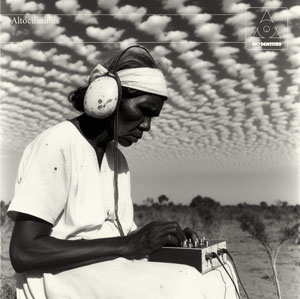
You can already listen to Altocumulus, the first track on the album.
Tom Bean, Member 41,135 has shared details of an art exhibition CUMULUS: THE ART OF METEOROLOGY, that’s opening in Flagstaff, Arizona on June 29. The exhibit will run for three months and coincide with the arrival of the Southwest US Monsoon Season. He told us “While Flagstaff, is a small city, it is the jumping off point for many of the 5 million annual visitors who come to see Grand Canyon National Park. This exhibit would be of interest to CAS members, who come from all around the world.“
You can see more about this exhibition on the Coconino Center for the Arts website
Diana Bander, Member 49,101, spotted this article on The Atlantic website. The article, written by Zoë Schlanger, begins with the sky near to the equator. It states, “clouds and wind run the show”, explaining that tropical cloud systems drive global atmospheric circulation, which determines the weather around the world. It draws on the thoughts of Da Yang, an atmospheric scientist, and Tiffany Shaw, a climate physicist, both from the University of Chicago.
Image Credit: Cumulonimbus clouds over the Maldives spotted by Emilia Fulgido, Member 47,092
A small-scale experiment was recently carried out by a team at the University of Washington to explore a potential tool in the fight against the climate crisis: marine cloud brightening. The idea is that spraying tiny particles of sea salt into marine Stratocumulus clouds – the low, clumpy layer cloud that can form over large bodies of water – might encourage them to form more droplets of smaller sizes and thereby appear brighter by reflecting more sunlight. This, the argument goes, would reflect the Sun’s heat back up into Space, helping to cool the oceans below.
This first experiment of its kind in the US was conducted on the deck of a ship in Alameda, California, where the team sprayed into the air a mist of sea-salt particles to see how their size would be affected by different atmospheric conditions. The crucial aspect for the team is for these sea-salt aerosols to be just the right size to encourage the cloud droplets to form. If the salt crystals are too small, they’d be ineffective; too large, and they could potentially make clouds less reflective rather than more.
The experiment has not been without pushback. Some have argued that projects like marine cloud brightening represent a stopgap measure that would distract from tackling the root causes of climate change. Others have raised concerns about the potential for unexpected side effects were we to try to change the nature of cloud cover over large areas. According to the lead scientist in the project, Dr. Robert Wood, another decade of testing and trials would likely be needed before marine cloud brightening is even something that could be implemented at any scale.
The next phase of this experiment is for the team to start to quantify any effects the particles of sea salt have on cloud reflectivity out in the open ocean.
To read more about this test, and marine cloud brightening in general, here is an article by The New York Times and another by the University of Washington itself outlining further details.
Chicago’s Filament Theatre are in the final week of their production of Cloud Man.
Filament Theatre is the premier theatre for young audiences on Chicago, Illinois’ Northwest Side, and is delighted to present the magical Constellation Points’ Cloud Man.
The production is thanks to a new partnership between Filament and the Scottish theatre company Constellation Points.
A cleverly staged show featuring one performer, puppets, storytelling and lots of clouds, Cloud Man explores the ways we try to make sense of the world. It encourages audiences to notice the beauty and wonder to be found in everyday life. It’s a gentle lesson in the ways we can care for the world without controlling it.
Local adventurers can catch the final performances of Cloud Man April 27-28 by https://filamenttheatre.org/cloud-man/
Global adventurers can support Filament’s campaign to bring Cloud Man to schools and community spaces by visiting Filament Theatre’s website.
Instagram: @filamentplays
Facebook: Filament Theatre
The prehistoric peoples of the Colorado Plateau in the southwest United States knew a thing or two about clouds. And they shared their knowledge in the form of ‘cloud beings’ drawn and carved onto rocks that are still visible today…
This beautiful book about clouds by Nikki McClure is about the imagery she used to bring to life a long-forgotten television script by Rachel Carson, ‘Something About the Sky’ which aired on March 11, 1956. Nikki approached Rachel Carson’s estate and they granted permission for her to illustrate and publish the script. She explains that it’s full of Carson’s thoughts about the sky, and now it has become a book-shaped ‘something’ to inspire cloud gazing and wonder. The illustrations by Nikki McClure are mesmerising and this article shows how she created them.
You can read the full article here.
Thanks to Lisa Hixon, Member 49,482 for telling us about this.
Kathy Wilson, Member 58,037 recently told us about an exhibition by Andy Eccleshall entitled “Luminosity” that is showing at the Seattle Art Museum Gallery until 31st March 2024. Andy was previously a muralist but is now focusing on cloud art and with pastoral landscapes to the far reaches of the sky, Luminosity spotlights his work.
Read more about the exhibition on the My Edmonds News website
Cumulonebulous is an exhibition currently running until 23rd March 2024. It features works by Chris Dorland, Thomas Hart Benton, Jacob Jackmauh, Tim Lyons, Elbert Joseph Perez, Nora Maité Nieves, Rachel Rosheger, and Viktor Timofeev.
Exhibition Preview
Book a Viewing Appointment
Image: Thomas Hart Benton, Threshing, 1941, Lithograph (ed. of 250), 9 1/4 × 13 3/4 in (23.5 × 34.9 cm)
A recent study has shown that Cumulus clouds begin to disappear during partial solar eclipses. The study, published in the journal Communications Earth & Environment in early February 2024, used satellite cloud measurements from three solar eclipses between 2005 and 2016, and the results showed that Cumulus clouds over land began to dissipate when around 15% of the Sun’s disc was obscured by the Moon. This is because Cumulus clouds feed off columns of rising air, called thermals, and these rising thermals are formed by the heat of the Sun shining down onto the ground. As the Sun begins to be obscured, less of its heat reaches the ground, halting the formation of Cumulus clouds. This halting is, however, only temporary, for Cumulus begin to form once more after a solar eclipse has passed.
The findings of this study show that scientists may be underestimating the amount of solar radiation that reaches Earth during solar eclipses, for low, thick clouds, such as Cumulus, tend to reflect solar radiation and have a cooling effect on the planet. That solar eclipses affect cloud cover has implications with proposed climate engineering techniques. As Victor Trees, one of the researchers who worked on the study, said: ‘This could be a warning for climate engineering. If we eclipse the Sun in the future with technological solutions, it may affect the clouds. Fewer clouds could partly oppose the intended effect of climate engineering, because clouds reflect sunlight and thus actually help to cool down the Earth.’
To find out more about the relationship between Cumulus clouds and solar eclipses, you can read this article published by Phys.org (which includes a direct link to the study in full).
Image: NASA
The English word ‘cloud’ stems from the Old English clūd, meaning ‘boulder’. It is therefore fitting that the clouds on distant exoplanet WASP-107b are made of particles of silicate – minerals that are often the main constituents of sand. It is thought that the sand on WASP-107b behaves in a way reminiscent of Earth’s own water cycle: particles of silicate form clouds in the upper atmosphere. These particles then rain back down into the hotter layers of the planet’s atmosphere below, where they evaporate. In its gaseous phase, the silicate then rises and condenses back into the solid particles of cloud. This process then repeats in cycles, rather like the water cycle on Earth – but with sand!
NASA’s James Webb Space Telescope was used to carry out this research. It is the first time the chemical composition of another planet’s clouds has been detected, and its findings provide a unique insight into both the differences and similarities that can exist on planets other than our own.
You can read more about these clouds of sand in this NPR article.
Image: What would clouds of sand look like? Nobody knows, but probably not like the above since it’s an upside-down photo of the Sahara Desert. Image © Pierre André CC BY-SA 4.0.
An exhibition showing clouds portrayed in both art and photographic form is currently happening in Zürich, Switzerland, running until March 10, 2024.
A collaboration between the Image Archive and the Graphic Collection of ETH Zürich, the exhibition covers different printmaking techniques involved in cloud imagery, as well as asking philosophical questions about the very nature of capturing images of clouds. As the official press release says, ‘Constant movement and ever-changing form are of the essence of clouds. Their mobility and variety make them impossible to pin down – yet, by the same token, clouds can be anything: from the sublime embodiment of longing and an ominous portent, to the dwelling of the gods, to a mere accumulation of condensed water. But if the essence of clouds consists in their perpetual motion and formal metamorphosis, how can they be captured in an image?’
You can find out more about this exhibition by visiting the ETH Zürich’s website.
The exhibition is being held at:
ETH Zurich
Graphische Sammlung
HG E 52
Rämistrasse 101
8092 Zurich
Switzerland
+41 44 632 40 46
info@gs.ethz.ch
Image: Einsame Farm auf der öden Hochfläche Südafrikas bei Kimberley by Arnold Heim
© ETH Library, Image Archive
Noreen Reilly, Member 48,298, sent the link to an article published on the CNN website about the purple-pink streak of light that looks like an aurora when it hovers over the Norther Hemisphere but is in fact, something completely different known as ‘Steve’.
The two aurora scientists mentioned in the article, Dr Elizabeth MacDonald and Dr Eric Donavan, have both been experts on Cloud Appreciation Society Sky Holidays to view the aurora in Canada.
You can read the full article and see more images on the CNN website
Emily Fischer is an editorial fellow with Midstory, a non-profit ‘thinkhub’ in the Midwest which encourages the exchange of ideas and envisions the future of the region through multimedia storytelling. She contacted us as she was working on a story about how asperitas clouds have been seen across the Midwest and wanted to include information about the cloud’s official recognition. Society founder, Gavin Pretor-Pinney was pleased to help and worked on the story with Emily, sharing with her the background to its recognition and describing it as “Very much like the surface of the ocean when you’re underneath, looking up. But not on a kind of calm day with regular waves — more on a chaotic, choppy day”. Emily told us “I’m so honored to have your perspective as an integral part of its discovery!”
The article is very detailed and well written. You can read it in full here
Sing Blues in Grey, an exhibition showing off thirty paintings and watercolours of the moody cloud-heavy Scottish skies by American artist Jon Schueler, is running in Eton, Berkshire, England from 28th September until 5th November, 2023.
For more information on how to attend this event, please visit the official exhibition’s website via this link.
Image: © Jon Schueler
We tend to think of clouds as being an Earth-based phenomenon, but they also exist on other planets. On Neptune, the Solar System’s furthest planet from the Sun, cloud coverage appears to correlate with the 11-year solar cycle. The blue ice giant planet is usually covered in bands of white cloud, which become more frequent two years after the solar cycle’s peak, where the Sun’s activity increases. However, since 2019, the clouds have been disappearing, with latest imagery from the Keck II telescope showing clouds being found only on the planet’s southern pole. ‘This is extremely exciting and unexpected, especially since Neptune’s previous period of low cloud activity was not nearly as dramatic and prolonged,’ said Erandi Chavez, of the Center for Astrophysics | Harvard-Smithsonian (CfA).
To discover more about this fascinating finding, you can read this article published on NASA’s website.

Images: NASA, ESA
Clotilde Wang, Member 37,435, recently told us about a French broadcast entitled “Head in the Clouds”. The translated programme description states:
“At the beginning of autumn, the course of the clouds parades, carrying showers and clearings. If we cannot grasp them with our hands, we can nevertheless grasp them through the arts and sciences. From the mapping of clouds, which reveals their territories to us, to meteorological engineering, which makes it possible to make rain fall, through their pictorial and poetic study, we learn to know them better”.
You can listen to the broadcast here
Image: Cirrus over Rossmoyne, City of Canning, Western Australia, Australia © Rosa Bud
Noctilucent clouds, also known as polar mesospheric clouds, are ice-crystal formations found in a region of the upper atmosphere called the mesosphere. They form at altitudes of 50 miles (80 km), right up near the fringes of Space, making them Earth’s highest clouds. Named with the Latin for ‘night shining’, they have a bluish glow as they catch the light when the rest of the sky is dark. The clouds are seen only during twilight hours when the Sun is below the horizon (between 6° and 16° below, to be precise). They are only visible during summertime, and from mid-to-high latitude regions of the world.
Over the past few decades, sightings of noctilucent clouds have become more frequent. They have been seen from more extensive regions, appearing further south in the Northern Hemisphere, for instance. It is possible the increasing frequency of this mysterious and ghostly formation is a consequence of our warming climate.
You can read more about noctilucent clouds and their possible connections to climate change in this BBC Sky at Night Magazine article.
Photograph: noctilucent clouds spotted over Schleiz, Germany by Juergen Klimpke.
Marilyn Murphy, artist and CAS Member 41,144, shared with us the news that Vanderbilt University’s Ralf Bennartz is to lead a NASA mission to study ice clouds. This is a NASA satellite mission, supported by a grant of up to $37 million, aimed at better understanding Earth’s high-altitude ice clouds. Ralf Bennart, Stevenson Chair and professor of earth and environmental sciences, will lead the mission, which will underscore Vanderbilt’s cutting-edge contributions to comprehending our planet’s climate.
You can read the full article on the Vanderbilt University website.
ATTENTION ALL AMATEUR WEATHER PHOTOGRAPHERS! Enter your best weather photos in the 2023 Weatherwise Photography Contest. Winners will be featured in the September/October 2023 issue. One grand prize, one first prize, two second prizes, three third prizes, and several honourable mention prizes will be awarded.* All winners receive a one-year online subscription to the only magazine about the weather – Weatherise. SEND IN YOUR ENTRIES TODAY!
Hans-Georg Arzt, Member 44,560 send us details of this exhibition at Museum Sinclair-Haus, Löwengasse 15, 61348 Bad Homburg v.d.H. It is running from 19th March to 13th August and you can see more about it on the gallery website or by downloading the exhibition catalogue
Heike Negenborn, Member 8,845, an artist from Windesheim, Germany currently has a solo exhibition entitled “Landscape Stories” at the Galerie Hübner & Hübner, Frankfurt. It’s running from 17th March to 22nd April 2023.
The subtitle of this Netscape is “Changing Landscape”. The artist explaineds “In the series of monumental overview landscapes, which were awarded the Palatinate Prize for Fine Arts and the Wilhelm Morgner Prize, I combine cloud and earth fragments with perspectively fanned-out grids, which transform into digital pixels dissolve and mutate into network landscapes, into Netscapes. The reshaping of the cultural landscape is underpinned by the reduction of my otherwise strongly colored palette to black and white tones and by the depiction of the landscape as a construct. Clearly visible construction and perspective lines reveal my strategies and support the depth effect in the picture. The works deal with the relationship between nature, its image and its multimedia transfer possibilities.”
You can find out more about Heike and her work on her website


